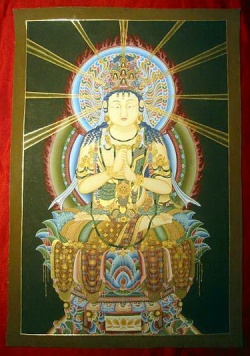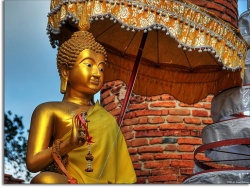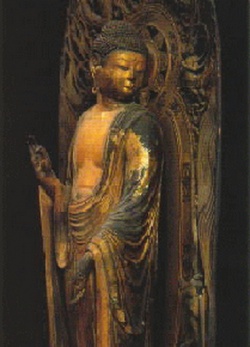First Turn of Dharma Wheel
According to Buddhist tradition, Buddha Shakyamuni kept silent during forty-nine days after his Enlightenment and was not giving any teachings. His first sermon he gave in front of five ascetics-beggars, his former companions in travels and truth-seeking. Buddha, or Siddhartha Gautama at the time, clearly realized that asceticism doesn’t lead to liberation from sufferings. He turned off from the path of destitution and his friends left him alone. His five comrades condemned actions of Siddhartha as betrayal of their ideals and swore never to talk to this guy again. According to their point of view, such a change in Siddhartha demonstrated his disloyalty to their ascetic lifestyle. However, when they accidently met him after his enlightenment, they felt a sudden sympathy towards him. And in front of those very comrades Buddha gave his first sermon in the Deer Park near Sarnath, trying to explain the fundamentals of his teaching.
In course of this conversation, which later received the name of “First turn of the Wheel of Dharma”, Buddha expounded fundamentals of his teaching about Four Noble Truths. As many of you know, these Truths were: Truth of Suffering, Truth of Causality of Suffering, Truth of Cessation of suffering and Truth about the Path leading to cessation of suffering.
According to Sutras of first turn of Dharma wheel, Buddha explained the doctrine of Four Noble Truths from the viewpoint of its three aspects, particularly – the nature of Truths themselves, their particular applicability and results of their full implementation. The first part explains the meaning of each truth, second part – the importance of understanding the real particular value of each one of them by practitioner, an understanding that a fact of suffering should be recognized and its causes – eliminated, that there is a need to end sufferings and the path leading to cessation of sufferings should be gone.
Regarding the third part, Buddha defined it as reaching the final goal – as full realization of Four Noble Truths and particularly – full awareness about sufferings, complete elimination of causes of suffering, full awareness of necessity to end sufferings and full realization of the path leading to cessation of sufferings. The teaching on Four Noble Paths forms the fundament of all the rest parts of Buddhist theory and practice.
All efforts and search of living beings are directed towards finding happiness and avoid suffering. Thirst for happiness and trying to avoid pain and sufferings is characteristic to all beings and doesn’t need excuses. However – happiness and sufferings doesn’t arise from nothing. They originate as a result of causes and conditions. In other words, teaching on Four Noble Truths proposes principle of causality. For this reason very generally we can sum up Buddhist teaching to 2 main principles:
1. the adoption of a worldview that takes into account the interdependence of all phenomena, i.e. mutually causal relationships of all things and events, and
2. for this reason, to lead a non-violent lifestyle that doesn’t harm to anyone.
Buddhism supports a non-violent behaviour due to two very simple and obvious assumptions:
1. as living beings nobody wants sufferings for him/herself and
2. sufferings have their causes and conditions.
According to Buddhism, the main cause of our misery and sufferings is our own ignorance and lack of discipline of our mind. Therefore, if we do not want to suffer, it would be logical for us to avoid destructive actions that naturally lead us to such results as pain and suffering. Pain and suffering are never in isolation, they appear as results of causes and conditions.
For a better understanding of the nature of mind and how it is conditioned by causes and conditions, an important role plays the principle of dependant origination. This principle explains that the result depends on its cause. And if we don’t want the result, we should eliminate its causes.
In teaching on Four Noble Truths we can see two separate groups of cause-and-effect connections: suffering is a result and causal nature of suffering – its cause; in a similar way the real cessation of sufferings, peacefulness – is a result and path, leading to it – a cause of peacefulness.
The happiness, which we would like to obtain, real and everlasting peacefulness and happiness, we can find only by purifying our mind. It will become possible when we will eliminate the main cause of all sufferings and misery, our ignorance and confusion. Freedom from suffering, a real cessation of them, can be reached only when we will be able to see the reality beyond illusions, created by our habit to stick to externally existing phenomenal world, and see the true nature of reality.
But to reach it we should reach perfection in three noble practices.
The practise of insight into essence of all things, wisdom, is a real remedy against confusion and all defilements arising from it. But only when the practice of highest wisdom comes together with a highly developed concentrationn one can focus all energy and attention to chosen object of meditation without any distractions. It means that practice of highest concentration is a necessary condition on the upper levels of applying the wisdom, developed by means of ability of insight in the true nature. However, for both types of practice (highest concentration and highest wisdom) to develop successfully, practitioner should first create a solid foundation of morals, starting to live an ethically healthy lifestyle.


